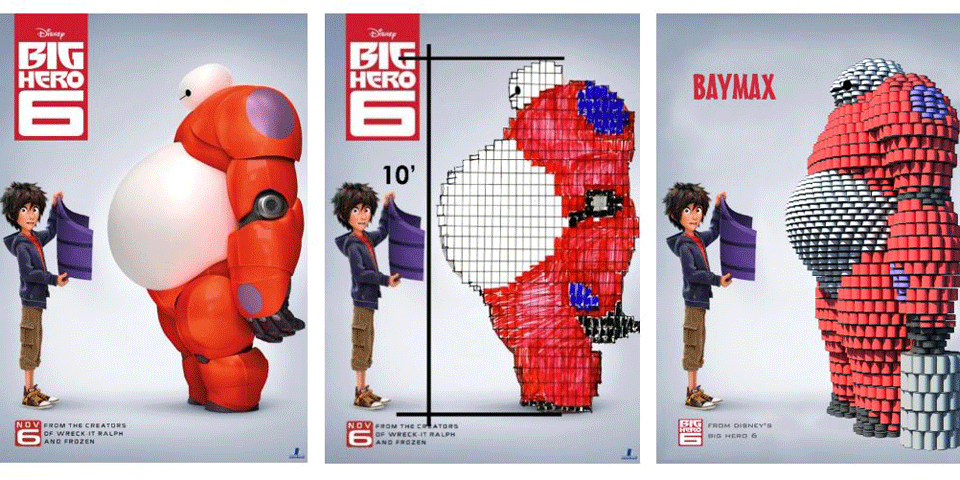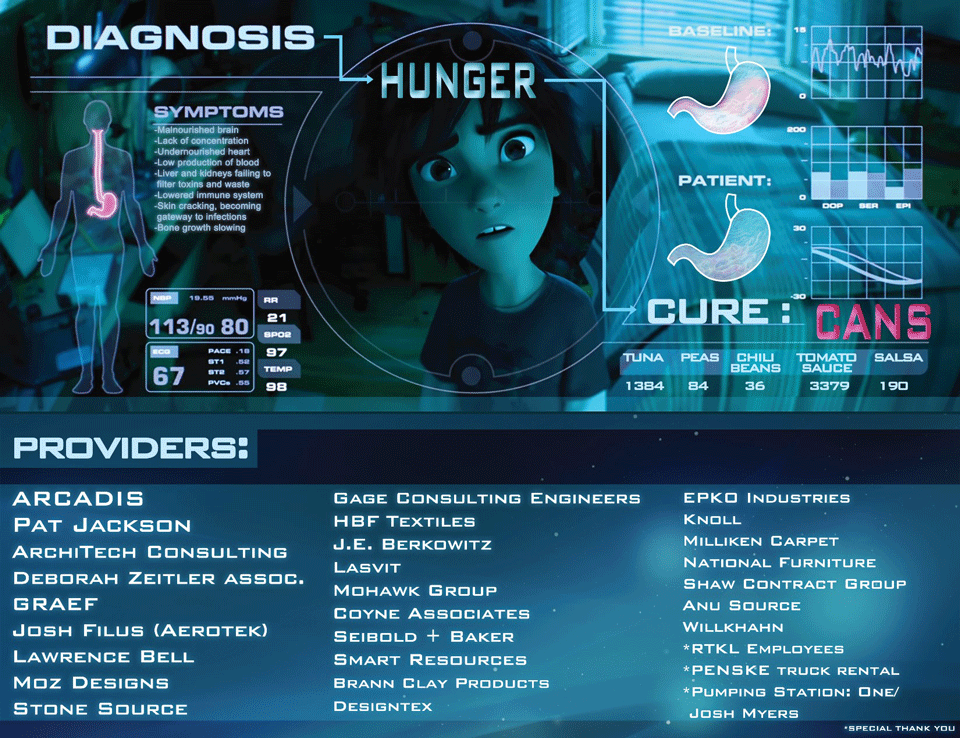
Baymax Helps Fight Hunger
Baymax, Disney’s lovable, inflatable robot, recently helped a team from CallisonRTKL Chicago lessen the effects of one of the Windy City’s biggest social issues: Hunger.
A study conducted in 2012 by Feeding America reported a staggering number of Chicagoans who face “food insecurity”. Nearly 800,000 people in Cook County do not know when [or from where] their next meal will come. Helping provide such a basic need to these less fortunate members of our community is a philanthropic project I can get on board with.
So how did we help combat hunger in our community? We built an awesome robot, obviously! Ok, kind of…
As part of the annual Canstruction Chicago event, a partnership between the Greater Chicago Food Depository and AIA Chicago, architecture and engineering firms from around the city use their design skills to create incredible structures using canned goods. The cans are donated to the Greater Chicago Food Depository after the event.
There were four major steps in this year’s process:
- Design/Model
- Fundraising
- Pre-Fabrication
- Build
Design/Model
We had a few different ideas for what we could build, but we ultimately selected Baymax. We heard that in the past, the cute characters from movies are often favored to win awards…so this may have influenced our decision a little. We also thought Baymax’s big belly might be a bit of a structural challenge, giving us points for structural ingenuity. Challenge accepted.

One obstacle of building something out of cans is that your pixel size is fairly large. If you can do your whole build out of tuna cans, you can get a much better resolution, but 10,000 tuna cans get pretty expensive. Label color, can size and cost are the main criteria we based our selections on. We also wanted to make sure the food we were buying would actually be desirable for the food depository. We found some cans that were only 3” high and very affordable to use on most of Baymax. Then we decided to use tuna cans in strategic places. We had to use 2 tuna cans stacked with boards between to supplement the height difference between the tuna can and its 3”-tall neighbor. We spent a lot of time creating and tweaking the Revit model to make sure we would have a structurally stable, and good-looking canned robot.
Fundraising
In previous years, we teamed up with an engineering firm (they would have been helpful with our “belly” structural issues!), but this year we were on our own. This made fundraising a little more difficult, as we were only pulling names from our own contact list. We created a website and a PayPal account to help our efforts and then sent a LOT of emails. We ultimately exceeded our goal, allowing us to buy 5,073 cans of food, as well as make a cash donation to the food depository. Baymax would still just be a Revit model if it weren’t for the help of all of our generous sponsors.
Pre-Fabrication
Once we were satisfied with our model, we were able to export plans of each level, showing the location of each can, labeled to identify which color of can should be placed there. This is a very important step in order to speed things up on the build night.
In previous years, these plans were cut out and then traced onto boards, which were cut by skill saws. Then the paper plans would be adhered to the boards to help with can placement. This year, however, we decided to try a more high-tech approach, after all we’re dealing with constructing a robot here. The plans were exported to CAD and laid out onto “boards” in the file. We were then able to set up the files to be cut on a CNC router. The perimeter of the each can was inset slightly and etched into the board. Although more accurate, and less labor intensive than cutting by hand, the task was quite time consuming. The board cutting team spent some long nights at the workshop. (Shout out Pumping Station: One!)
(We later realized we needed some chip board layers to make up differences in height from the tuna cans to our 3” cans, so we did end up having an X-acto knife-all-hands-on-deck cutting party. Yay for team-bonding!)
Build
After four months and many hours of work, the build night finally arrived! Anticipation was high and “we CAN do it” puns were in full force. We arrived at the Merchandise Mart and loaded everything into our allotted 10’x10’ space, then started building at 6pm. Everything was going smoothly until we realized we were missing one board. Thankfully, with some quick thinking (and an extra supply of chipboard) we were able to cut a few layers for a make-shift board on-site. After that, it was smooth sailing. We each took our turns placing cans and handing boards up ladders. It was a well-oiled machine by the end of the night. We finished in 6 hours and were rewarded with a huge feeling of accomplishment.
As a team of mostly inexperienced Canstruction workers, we were very proud of our structure. There are a few things that we would do differently next time around, but I think we did a lot right. Eliminating hunger in Chicago will take a lot more than one event, but every can counts. Baymax cares and so does CallisonRTKL.
Check in to CallisonRTKL.com this Friday, September 4th to see if Team CallisonRTKL won this year’s competition.



Awesome Job you guys !!! Fist Bump – ba la la Lala !!!